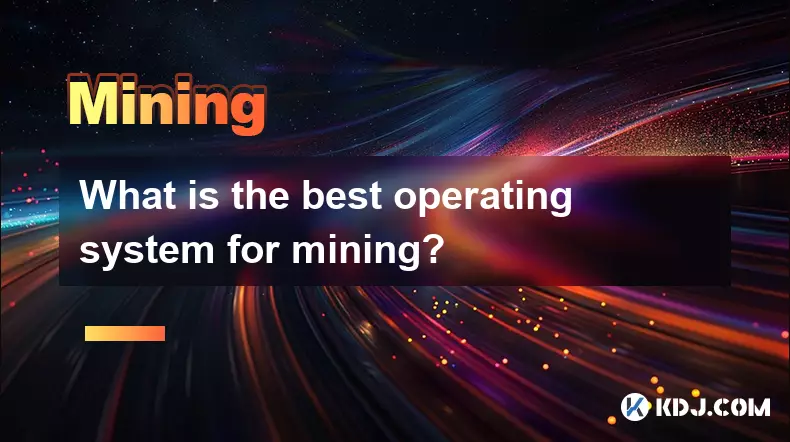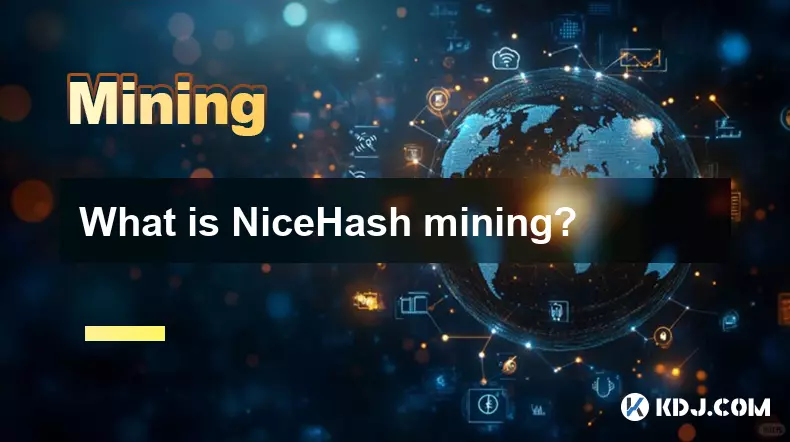-
 bitcoin
bitcoin $106680.127705 USD
0.67% -
 ethereum
ethereum $3615.722480 USD
-0.65% -
 tether
tether $0.999925 USD
-0.04% -
 xrp
xrp $2.550072 USD
5.91% -
 bnb
bnb $1002.572269 USD
-0.90% -
 solana
solana $168.746669 USD
1.08% -
 usd-coin
usd-coin $0.999832 USD
-0.03% -
 tron
tron $0.297244 USD
1.97% -
 dogecoin
dogecoin $0.182965 USD
0.71% -
 cardano
cardano $0.600432 USD
2.56% -
 hyperliquid
hyperliquid $41.439691 USD
-1.57% -
 chainlink
chainlink $16.548399 USD
2.40% -
 bitcoin-cash
bitcoin-cash $524.993680 USD
3.45% -
 stellar
stellar $0.302259 USD
4.10% -
 zcash
zcash $539.994871 USD
-16.31%
What is the best operating system for mining?
Linux dominates crypto mining due to its efficiency, security, and support for specialized OSes like HiveOS and RaveOS, enabling optimal performance and remote management for large-scale operations.
Nov 01, 2025 at 02:36 pm

When it comes to cryptocurrency mining, the choice of operating system plays a critical role in efficiency, stability, and hardware compatibility. Different miners have varying needs depending on their setup—whether they're running a single GPU rig or managing a large-scale mining farm. The performance, driver support, and resource overhead of an OS can significantly influence hash rates and uptime. While several operating systems are used across the mining community, each has distinct advantages tailored to specific scenarios.
Why Linux Dominates the Mining Landscape
1. Linux is widely regarded as the top choice for serious miners due to its lightweight nature and open-source flexibility. It consumes fewer system resources, leaving more power available for mining processes.
- Most major mining software, such as CGMiner, BFGMiner, and PhoenixMiner, offer native Linux support with optimized configurations. This allows for fine-tuned control over overclocking and fan settings.
- Linux distributions like Ubuntu and HiveOS are specifically adapted for mining operations. HiveOS, built on Linux, provides remote management, monitoring dashboards, and automatic failover features ideal for farms.
- Security is stronger on Linux compared to consumer-grade operating systems. With fewer background services and a lower attack surface, mining rigs are less vulnerable to malware.
- The ability to run headless (without a GUI) reduces overhead and increases stability, which is essential for 24/7 mining operations.
Windows: Accessibility vs. Performance Trade-offs
1. Windows remains popular among beginners because of its user-friendly interface and broad hardware compatibility. Drivers for GPUs from NVIDIA and AMD are easily accessible and regularly updated.
- Mining applications like NiceHash and MSI Afterburner integrate seamlessly with Windows, simplifying setup for novice users.
- However, Windows runs numerous background processes that consume memory and CPU cycles, reducing overall mining efficiency.
- Licensing costs and higher vulnerability to viruses make Windows less suitable for large-scale deployments.
- Despite these drawbacks, many small-scale miners continue to use Windows 10 or Windows 11 due to familiarity and plug-and-play ease.
Specialized Mining Operating Systems Gaining Traction
1. HiveOS has emerged as a leading platform for professional mining farms. It supports thousands of rigs simultaneously and offers cloud-based control through a web dashboard.
- Another option, RaveOS, provides similar functionality with real-time analytics, Telegram alerts, and API access for automation.
- These systems are based on Linux but come preconfigured for mining, supporting multiple algorithms and wallet integrations out of the box.
- They allow quick deployment of new rigs and enable immediate troubleshooting via SSH or remote console access.
- Features like auto-restart on crash, temperature-based throttling, and dynamic power management enhance reliability without manual intervention.
Frequently Asked Questions
Q: Can I use macOS for cryptocurrency mining?A: Technically yes, but macOS is not recommended. Apple has deprecated GPU drivers necessary for efficient mining, and most modern mining software lacks macOS support. Additionally, Mac hardware is expensive and underpowered relative to dedicated mining rigs.
Q: Is it safe to mine on an OS installed on an SSD?A: Yes, as long as the SSD has sufficient endurance and over-provisioning. Mining does not involve heavy write operations, so typical wear is minimal. However, using a separate drive for the OS helps isolate system files from potential failures.
Q: Do I need a GUI for mining, or can I operate without one?A: A GUI is not required. In fact, headless setups using command-line interfaces are preferred in professional environments. Remote access tools allow full control without needing monitors or input devices connected to the rig.
Q: How often should I update my mining OS?A: Updates should be applied cautiously. While security patches are important, updating too frequently may introduce instability. Stick to stable releases and test changes on a single rig before rolling them out across your entire operation.
Disclaimer:info@kdj.com
The information provided is not trading advice. kdj.com does not assume any responsibility for any investments made based on the information provided in this article. Cryptocurrencies are highly volatile and it is highly recommended that you invest with caution after thorough research!
If you believe that the content used on this website infringes your copyright, please contact us immediately (info@kdj.com) and we will delete it promptly.
- CFTC, Crypto, and Congress: Navigating the Murky Waters of Market Oversight
- 2025-11-11 10:55:01
- XRP: Is This Crypto's Best-Performing Asset?
- 2025-11-11 06:45:01
- Navigating the Crypto Maze: Economic Schedules, Treasury Auctions, and the Bitcoin Beacon
- 2025-11-11 07:40:01
- BitMine, ETH, and Assets: Navigating the Crypto Landscape Like a New Yorker
- 2025-11-11 13:00:02
- Exodus & Grateful: Stablecoin Payments Take Center Stage
- 2025-11-11 10:10:01
- AVAX & OP: Price Prediction, Open Interest, and Recovery Gains - What's Next?
- 2025-11-11 06:50:02
Related knowledge

What is the block reward in mining?
Nov 06,2025 at 12:35am
Understanding Block Rewards in Cryptocurrency Mining1. The block reward is the incentive miners receive for successfully validating and adding a new b...

How do mining algorithms work?
Nov 06,2025 at 04:59am
Mining Algorithms and Their Role in Blockchain Networks1. Mining algorithms serve as the backbone of blockchain consensus mechanisms, ensuring that tr...

What is NiceHash mining?
Nov 06,2025 at 07:40am
NiceHash mining refers to the process of renting out computational power to individuals or organizations seeking to mine cryptocurrencies without owni...

Does an antivirus program affect mining?
Nov 05,2025 at 09:29pm
Understanding Decentralized Exchanges in the Crypto Ecosystem1. Decentralized exchanges (DEXs) operate without a central authority, allowing users to ...

What is the history of Bitcoin mining?
Nov 05,2025 at 08:15pm
Within the fast-moving world of cryptocurrency, new developments emerge daily, reshaping how investors, developers, and institutions interact with dig...

How is the energy consumption of mining justified?
Nov 05,2025 at 10:20pm
Energy Consumption in Cryptocurrency Mining1. The energy consumption associated with cryptocurrency mining has drawn significant attention from enviro...

What is the block reward in mining?
Nov 06,2025 at 12:35am
Understanding Block Rewards in Cryptocurrency Mining1. The block reward is the incentive miners receive for successfully validating and adding a new b...

How do mining algorithms work?
Nov 06,2025 at 04:59am
Mining Algorithms and Their Role in Blockchain Networks1. Mining algorithms serve as the backbone of blockchain consensus mechanisms, ensuring that tr...

What is NiceHash mining?
Nov 06,2025 at 07:40am
NiceHash mining refers to the process of renting out computational power to individuals or organizations seeking to mine cryptocurrencies without owni...

Does an antivirus program affect mining?
Nov 05,2025 at 09:29pm
Understanding Decentralized Exchanges in the Crypto Ecosystem1. Decentralized exchanges (DEXs) operate without a central authority, allowing users to ...

What is the history of Bitcoin mining?
Nov 05,2025 at 08:15pm
Within the fast-moving world of cryptocurrency, new developments emerge daily, reshaping how investors, developers, and institutions interact with dig...

How is the energy consumption of mining justified?
Nov 05,2025 at 10:20pm
Energy Consumption in Cryptocurrency Mining1. The energy consumption associated with cryptocurrency mining has drawn significant attention from enviro...
See all articles










































































